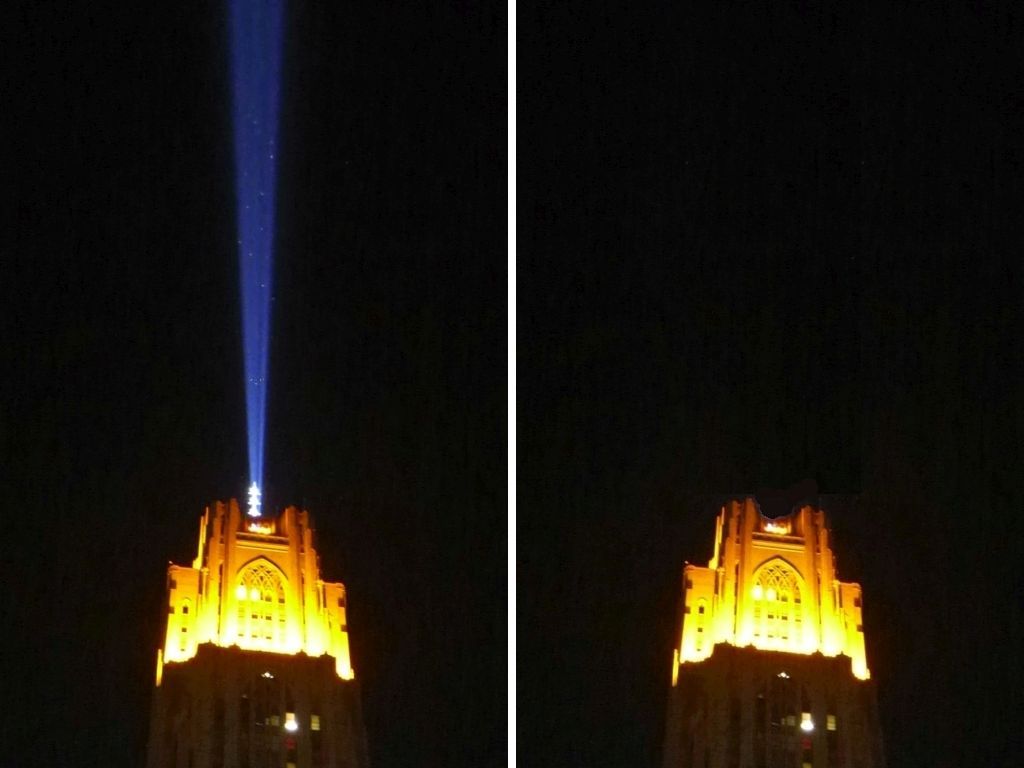
Good news for birds today!
On October 8th I reported how migrating birds are fatally attracted to artificial lights and how Pitt’s new Victory Lights trapped birds in its blue beams. Within 24 hours the Audubon Society of Western Pennsylvania (ASWP) and the University of Pittsburgh began collaborating on a solution. Here’s the good news from Pitt this week:
Just want you to know that we’ve worked on the Victory Lights issue in conjunction with the Audubon Society of Western Pennsylvania. During migration season, the light — which is only on after Pitt football victories and championship victories by other Panthers teams — will be cycled on for 45 minutes and off for 15 every hour. We’re really glad to have been made aware of this situation. Thank you.
— Joe Miksch, Dir. of Media Relations, Univ of Pittsburgh, 22 Oct 2018
The photos above simulate the effect: Left side is 45 minutes on, right is 15 minutes off.
The solution is based on studies done at the 9/11 Tribute of Light in New York where 88 beams light the sky once a year.
Every September New York Audubon mobilizes volunteers to watch the 9/11 Tribute for trapped birds. When volunteers count 1,000 birds circling in the beams or if a bird is found dead, the lights are turned off for 20 minutes. Radar shows that after only 10 minutes of darkness trapped birds have left the 9/11 Tribute and are flying south toward Governor’s Island. The Tribute is kept dark for 20 minutes for good measure.
The “45 minutes on, 15 minutes off” solution takes advantage of Pitt’s computerized light system and the unscheduled nature of the Victory Lights display. Every hour during migration — whether birds are trapped or not — the blue beams will cycle. After 15 minutes of darkness, any birds that are trapped at Pitt will probably be flying over Schenley Park, headed for Hays Woods.
This solution is just the beginning. Pitt and ASWP will continue to monitor the situation during migration and tweak the timing if necessary.
Kudos to the University of Pittsburgh and Audubon Society of Western Pennsylvania for collaborating and handling the issue so quickly. Special thanks to Pitt for setting such a great example for building owners. Thank you, Pitt and ASWP!
If Pitt beats Duke this Saturday, October 27, the blue lights will cycle every hour. Go Pitt!
For more information see: Deadly Attraction, Part 2 (Pitt Victory Lights), Deadly Attraction (Pittsburgh city lights), New York Times Opinion: The Deadly Lure of City Lights (9/11 Tribute)
(photo simulation by Kate St. John)
(*) Special thanks to Jim Bonner Executive Director of ASWP and Chancellor Gallagher at the University of Pittsburgh and to everyone behind the scenes who made this good news possible. Thank you!
UPDATE 10 October 2019, Pitt News article by Jessica Steinberg: Birding Club to collect data on bird deaths from victory lights
This has nothing to do with the Pitt light. My sister lives in North Versailles and every evening there are hundreds or thousands of small birds (not crows) nesting in the trees of next to her house. She took a video. In the morning they leave. They even sit on the wires. Any ideas of what is going on and what they are?
Thank you!
Vicki, they might be grackles, starlings or blackbirds.
Pitt’s accommodation is good news. CMU has formidably bright lights every night in their inner campus near their stadium. I wonder if they are tall enough to affect birds migrating, and if so, is there any accommodation they could make? Do you know if their lighting has been studied regarding its affect on birds?
Betty, I don’t know if anyone has looked into CMU’s lights.
I haven’t looked for dead birds at CMU as part of BirdSafe Pittsburgh, but when birds migrate they do so pretty high up and will come down to feed at dawn, which is when most window strikes occur. CMU lights aren’t directed upwards so they wouldn’t attract birds high overhead.
And I say a hearty thanks to you Kate! Nice Job reporting!
Excellent! So good to hear some good news.
Great job!
Thanks to you, Audubon, and the University of Pittsburgh for trying to save these migrating birds. This is wonderful news.
Quite a few crows in Bloomfield yesterday – near Liberty from Bridge to 40th St. – 4 & 6 PM.
Good news that they are willing to shut the light off. I do have to wonder how large the carbon footprint is for this monstrosity of a light. I thought we should all try to conserve electricity……… Look at the great work done at the Carrick library to see how energy conservation is done!
Nice coverage in Saturday, Oct. 27 Post Gazette, giving you credit for starting the ball rolling.